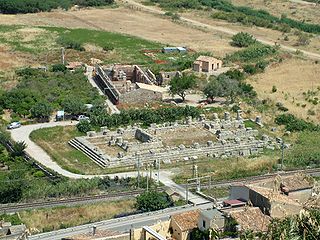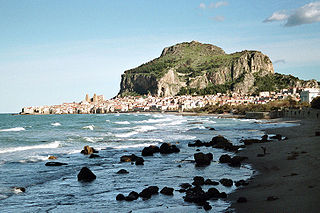Related Research Articles

Tindari, ancient Tyndaris or Tyndarion, is a small town, frazione in the comune of Patti and a Latin Catholic titular see.
Abacaenum was an ancient city of Magna Graecia in Sicily, situated about 6.5 km from the north coast, between Tyndaris and Mylae, and 13 km from the former city.

Caronia is a town and comune on the north coast of Sicily, in the province of Messina, about half way between Tyndaris and Cephaloedium. The town has 3,555 inhabitants.

Enna, known from the Middle Ages until 1926 as Castrogiovanni, is a city and comune located roughly at the center of Sicily, southern Italy, in the province of Enna, towering above the surrounding countryside. It has earned the nicknames belvedere and ombelico ("navel") of Sicily.

Himera, was a large and important ancient Greek city in Magna Graecia, situated on the north coast of Sicily at the mouth of the river of the same name, between Panormus and Cephaloedium in the comune of Termini Imerese.

Halaesa, also known as Halaesa Archonidea and also spelled Alaesa or Halesa was an ancient city of Magna Graecia in Sicily, situated near the north coast of the island, between Cephaloedium and Calacte.

Nicosia is a Town and comune of the province of Enna in Sicily, southern Italy. It is located at 720 m above the sea level, on a rocky massive culminating in four imposing hills. The origin of Nicosia is uncertain. Nicosia and Troina are the northernmost towns in the province of Enna. The vicinity was traditionally made up of salt mines and arable lands.
San Marco d'Alunzio is a city and comune (municipality) in the Metropolitan City of Messina in the Italian region Sicily, near the north coast of the island, located about 120 kilometres (75 mi) east of Palermo and about 80 kilometres (50 mi) west of Messina.

Heraclea Minoa was an ancient Greek city of Magna Graecia situated on the southern coast of Sicily near the mouth of the river Halycus, 25 km west of Agrigentum. It is located near the modern town of the same name in the comune Cattolica Eraclea in Italy.
Lagaria, was an ancient town of Magna Graecia in Lucania, situated between Thurii and the river Siris.

Aetna, was an ancient city of Magna Graecia in Sicily, situated at the foot of the mountain of the same name, on its southern declivity. It was originally a Sicelian city, and was called Inessa or Inessum.
Agathyrnum or Agathyrna, was an ancient city of Magna Graecia on the north coast of Sicily between Tyndaris and Calacte. It was supposed to have derived its name from Agathyrnus, a son of Aeolus, who is said to have founded the city. But though it may be inferred from this story that it was an ancient city, and probably of Spartan origin, we find no mention of it in history until after Sicily became a Roman province. During the Second Punic War it became the headquarters of a band of robbers and freebooters, who extended their ravages over the neighboring country, but were reduced by the consul Laevinus in 210 BCE, who transported 4000 of them to Rhegium. It very probably was deprived on this occasion of the municipal rights conceded to most of the Sicilian towns, which may account for our finding no notice of it in Cicero, though it is mentioned by Strabo among the few cities still subsisting on the north coast of Sicily, as well as afterwards by Pliny, Ptolemy and the Itineraries.
Ichana, was an ancient city of Sicily, which, according to Stephanus of Byzantium, held out for a long time against the arms of the Syracusans, whence he derives its name, but gives us no indication of the period to which this statement refers. The "Ichanenses", however, are mentioned by Pliny among the stipendiary towns of the interior of Sicily, though, according to some scholars, the true reading is "Ipanenses". In either case we have no clue to the position of the city, and it is a mere random conjecture of Cluverius to give the name of Ichana to the ruins of a city which still remain at a place called Vendicari, comune of Noto, a few miles north of Cape Pachynum, and which were identified by Tommaso Fazello as those of Imachara.

Ietas, was an ancient town of the interior of Sicily, in the northwest of the island, not very far from Panormus, in the modern comune of San Giuseppe Jato, whose name reflects the ancient town's.
Maktorion or Mactorium, was an ancient town of Magna Graecia in Sicily, in the neighborhood of Gela.
Hybla Gereatis, was an ancient city of Magna Graecia in Sicily, located on the southern slope of Mount Etna, not far from the river Symaethus, in the modern comune of Paternò. There were at least three cities named "Hybla" in ancient accounts of Sicily which are often confounded with each other, and which it is sometimes very difficult to distinguish.

Helorus, Heloros, Helorum, or Elorus, was an ancient Greek city of Magna Graecia in Sicily, situated near the east coast, about 40 km south of Syracuse and on the banks of the river of the same name. It is currently an archaeological site in the modern comune of Noto.

Netum or Neetum, was a considerable ancient town in the south of Sicily, near the sources of the little river Asinarus, and about 34 km southwest of Syracuse. Its current site is at the località of Noto Antica, in the modern comune of Noto.

Capo Passero or Cape Passaro is a celebrated promontory of Sicily, forming the extreme southeastern point of the whole island, and one of the three promontories which were supposed to have given to it the name of "Trinacria".

Cefalù, classically known as Cephaloedium, is a city and comune in the Italian Metropolitan City of Palermo, located on the Tyrrhenian coast of Sicily about 70 km (43 mi) east of the provincial capital and 185 km (115 mi) west of Messina. The town, with its population of just under 14,000, is one of the major tourist attractions in the region. Despite its size, every year it attracts millions of tourists from all parts of Sicily, and also from all over Italy and Europe. It is a member of the I Borghi più belli d'Italia association.
References
- ↑ Cicero In Verrem iii. 1. 8, 42, v. 7; Zumpt, ad loc.; Plin. iii. 8. s. 14; Karl Julius Sillig, ad loc.
- ↑ Ptol. iii. 4. § 12.
- ↑ Cluver. Sicil. p. 356; Tommaso Fazello de Reb. Sic. iv. 2, p. 217; Amico, Not. ad Fazell. pp. 417, 447; Richard Hoare, Classical Tour, vol. ii. p. 301.
 This article incorporates text from a publication now in the public domain : Smith, William, ed. (1854–1857). Dictionary of Greek and Roman Geography . London: John Murray.
This article incorporates text from a publication now in the public domain : Smith, William, ed. (1854–1857). Dictionary of Greek and Roman Geography . London: John Murray.{{cite encyclopedia}}: Missing or empty|title=(help)- Richard Talbert , Barrington Atlas of the Greek and Roman World , ( ISBN 0-691-03169-X ), Map 47 & notes.